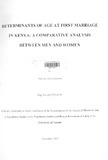| dc.description.abstract | The objective of the study was to examine the determinants of age at first marriage among men
and women in Kenya. Specifically, the study sought to establish the timing of marriage among
men and women in Kenya; the social economic, socio cultural and demographic factors
determining age at marriage in Kenya; and gender variations in the association between marriage
timing and socio-economic/socio-cultural/demographic variables; and to determine whether there
is any variation in the outlined associations.
To achieve the above objectives, several hypotheses were tested by applying the survival models
to male and female data drawn from the 2003 Kenya Demographic and Health Survey. The study
was guided by the 1988 United Nations framework for the study of marriage timing.
The dependent variable was duration to first marriage measured in single years. Eight
explanatory variables were utilized in the study and these included; highest level of education
completed, type of place of residence, place of residence (region), wealth index, employment
status, type of religion, ethnic group and age at first sex.
Life table methods were utilized in the analysis to estimate the differentials in the median age at
first marriage and establish the factors influencing age at first marriage among men and women
in Kenya. Life table analysis considered ever married men and women separately and estimated
their median ages as 24.1 and 19.0 respectively.
Important conclusions can be drawn from this study. Differentials in median age at first marriage
•
by various background characteristics and by sex are evident. For instance men had a higher
median age at first marriage. Also educated men and women had a higher median age at first
mamage.
Multivariate life table (Cox hazard regression) results revealed that level of education, place of
residence, region of residence, wealth index, employment status, type of religion, ethnicity and
age at first sex are significantly associated with age at first marriage among women. All the
above variables apart from place of residence and employment status were significant among
men. The findings also reveal gender variation in the associations.
The study recommends policies to put more emphasis on girl child education to prevent the risk
of early marriages.
At program level, the study recommends formation and/or strengthening of programs targeting
youth sexuality with a focus on reducing age at first sex. The study also proposes programs to
address poverty particularly among the poor male and female youth which is a paramount
catalyst for early marriage.
Lastly, the study recommends further research specifically longitudinal and qualitative to help
focus attention on important unstudied nuptiality areas such psychosocial or individual factors
influencing marriage in the marriage market. | en |

